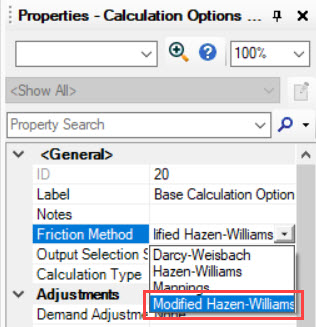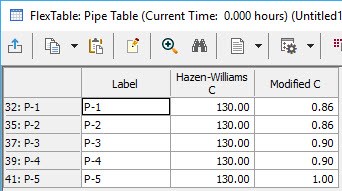| Product(s): |
WaterGEMS, WaterCAD |
| Version(s): |
CONNECT Edition, V8i |
| Area: |
Calculations |
Problem
How to use the Modified Hazen-Williams formula for analysis in WaterGEMS / WaterCAD?
Background
In some parts of the world the Modified Hazen-Williams formula is used in analysis of water supply and distribution networks.
The Modified Hazen-Williams formula is derived from the Darcy-Weisbach and Colebrook-White equations and is given as:
V = 3.83CRd0.6575(g.s)0.5525 / v0.105
Where,
CR = dimensionless coefficient of roughness
d = pipe diameter (m)
g = acceleration due to gravity (9.81 m/s2)
s = friction slope (HL / L)
v = viscosity of the fluid
For a circular pipe, using v = 10-6 m2/s (for water at 20° C) and g = 9.81 m/s2, the headloss equation becomes;
HL = L(Q/CR)1.81 / 994.62 d4.81
The coefficient of roughness for the Modified Hazen-Williams formula is “1” for very smooth pipes and reduces for rougher pipes. The coefficient will also reduce for higher design periods.
Solution
Starting with CONNECT Edition Update 2 (version 10.02.02.06) of the water products such as WaterGEMS, WaterCAD and HAMMER, the Modified Hazen-Williams method is now available for analysis.
Similar to the methods of Hazen-Williams, Darcy Weisbach and Manning's Equation; the Modified Hazen-Williams formula can be selected in the Calculation Options by navigating to Calculation Options > Friction Method.

When the Modified Hazen-Williams method is chosen as the Friction Method the value of "Cr" or Modified Hazen-Williams factor needs to be entered in the pipe properties. This field is automatically populated based on the material selected. By default it is populated as 1 for the material "Ductile Iron".
You can change the change the material from the Engineering Library and the Modified Hazen-Williams factor will be updated accordingly.

Download the sample model from here for a preview of using the Modified Hazen-Williams method for network analysis.
Alternative Approach for Older Versions
If you are using a version below 10.02.02.06 (i.e. CONNECT Edition Update 2) which does not have the Modified Hazen-Williams formula available, and you are not able to upgrade, the following workaround can be considered:
Step 1
Define a new User Data Extension (Tools > User Data Extensions) for Pipe. Setup the UDX as follows;
| Label |
Modified C (you can put your own custom label) |
| Data Type |
Real |
| Dimension |
No Units |
| Storage Unit |
“Blank” (keep this field blank) |
| Numeric Formatter |
Roughness – Hazen Williams |
The newly created User Data Extension would look like this;

Step 2
Check the pipe Flex Table and add the newly created “Modified C” column to the existing columns;

Step 3
Enter Modified Hazen-Williams C factors. (Setting display precision to 2 is best). Do not modify the order of the rows after this point. The below image represents what the you would see before modifying the Hazen-Williams C factors.

Note: The Modified Hazen-Williams C factors are entered depending on the smoothness of the pipe. For very smooth or new pipes the C factor would be “1”. For old pipes for which roughness has increased, the C factor would reduce.
The Modified Hazen-Williams C factors must be obtained separately for all the pipes in the network.
Step 4
Export this table to Excel using either Export to File or Copy with Headers and Paste In Excel, create a new column like New HW C.
Decide on what value of the traditional Hazen-Williams C corresponds to the value of 1.00 for the Modified Hazen-Williams C (i.e. the smooth pipe C). Here we are considering the value to be 150.
Calculate the new C values by multiply the Modified C values by the smooth pipe C.
For this case;
New HW C = Modified C * 150
New HW C = 0.9 * 150 = 135
The table in Excel would look like this;

Step 5
Copy the column New HW C into the Hazen-Williams C column in the Flex Table.

Step 6
Save the file with the new Hazen Williams C factors.
FAQ's
The Modified Hazen-Williams C factors change as per diameter. How to modify the existing C factors for multiple diameters?
In some cases (where diameters vary widely), the value of the smooth pipe C-factor can be function of diameter. In that case, the flex table can be filtered by diameter and the above steps can be repeated for each diameter.
Note: The above approach is limited to only versions below 10.02.02.06. For versions above 10.02.02.06 the values for Cr can be directly entered after filtering.
Does viscosity affect the headloss in the Modified Hazen-Williams formula?
The effect of viscosity changes is slight, and it would take a very large change in temperature to have any effect of hydraulic results.
What are the differences in headloss computed by Modified Hazen-Williams equation and Hazen-Williams or Darcy-Weisbach equations?
The differences depend on the range of roughness. For smooth pipes the differences are small while for very rough pipes they can be larger. However, if there are differences, the Darcy Weisbach equation is generally considered more accurate.
Engine Compatibility issue
When trying to use the Modified Hazen William method, the friction loss value goes for a toss. All the friction loss values come in thousands which is totally incorrect. This is happening only in the WaterGEMS 2.2.0 engine and the Modified Hazen Williams method. When selecting this combination, we can see the huge headloss in the system. The issue is logged as a bug with a bug number. #1312991. This issue will be investigated thoroughly and will be addressed in a future version/release. Currently, the possible workaround for you is to use WaterGEMS 2.00.12 Engine Compatibility which is giving good results and seems to work perfectly.
See Also
WaterGEMS Help topic "Hazen-Williams Equation"
WaterGEMS Help topic "Modified Hazen-Williams Equation"
WaterGEMS Help topic "Darcy-Weisbach Equation"